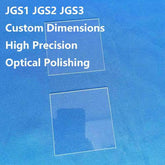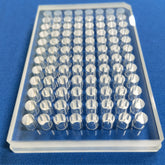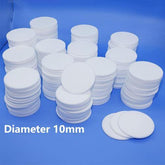Why quartz glass is commonly used in instruments? And differences in composition between quartz glass and crystal.
Why quartz glass is commonly used in instruments?
High temperature resistance
The softening point temperature of quartz glass is about 1730 ℃, which can be used for a long time at 1100 ℃ and can reach a temperature of 1450 ℃ in a short period of time.
Corrosion resistance
Except hydrofluoric acid, quartz glass hardly reacts with other acids. Its acid resistance is 30 times that of ceramics and 150 times that of stainless steel. Especially, its chemical stability at high temperature is unmatched by any other engineering material.
Good thermal stability
The coefficient of thermal expansion of quartz glass is very small, and it can withstand severe temperature changes. When the quartz glass is heated to about 1100 ℃, it will not burst when it is put into normal temperature water.
Good transparency
Quartz glass has good transmittance throughout the entire spectral range from ultraviolet to infrared, with a visible light transmittance of over 95%, especially in the ultraviolet spectral region, where the transmittance can reach over 80%.
Good electrical insulation performance
The resistance value of quartz glass is 10000 times that of ordinary glass, making it an excellent electrical insulation material with good electrical properties even at high temperatures.
Due to its excellent physical and chemical properties, quartz glass is widely used in various fields such as electric light sources, semiconductors, optical communication, military industry, metallurgy, building materials, chemistry, machinery, power, environmental protection, etc.
The formation of quartz glass is caused by the high temperature viscosity of its melt. It is widely used in the production of semiconductors, optical instrument, semiconducting communication devices, electro-optic sources, lasers, laboratory instruments, electrical equipment, medical equipment, high-temperature and corrosion resistant chemical instruments, chemical industry, electronics, metallurgy, building materials, national defense and other industries. The quartz glass produced by Shanghai Wechance Industrial Co., Ltd. has high bubble free precision, flat and smooth surface, corrosion resistance and good light transmittance, and is especially suitable for the observation window of optical, electronic, chemical, military and other optical instrument.

2、 Differences in composition between quartz glass and crystal
The main component of quartz glass and crystal is silicon dioxide, but they are not exactly the same.
Quartz glass is made by melting various pure natural quartz (such as crystal, quartz sand, etc.). The coefficient of linear expansion is extremely small, which is 1/10-1/20 of that of ordinary glass and has excellent thermal shock resistance. Quartz glass is an amorphous material with a single component of silicon dioxide. Its microstructure is a simple network composed of silicon dioxide tetrahedral structural units. Due to the large Si-O chemical bond energy and tight structure, quartz glass has unique properties. Especially transparent quartz glass has excellent optical performance, with excellent transmittance in the continuous wavelength range of ultraviolet to infrared radiation.
Crystal is a rare mineral, a kind of gem, quartz crystal, which belongs to the quartz family in mineralogy. The main chemical component is silicon dioxide, with the chemical formula SiO2. When silica crystal is perfect, it is crystal; The imperfect crystal is quartz: after silica gel dehydration, it becomes agate; The silica gel containing water becomes opal after solidification; When the silicon dioxide grain is less than a few microns, it forms chalcedony, chert and secondary quartzite.







